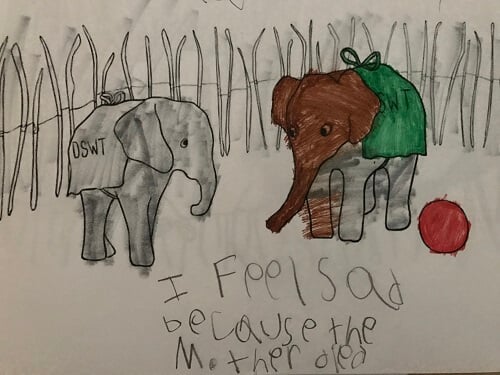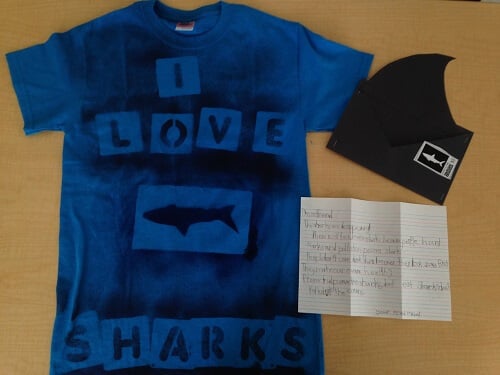PETA’s TeachKind is a humane-education resource for schools and educators looking to promote kindness and compassion for animals in the classroom. Through free lesson plans and other materials, classroom presentations, advice, online resources, and more, educators are teaching children to have empathy for all beings and helping to build a better, more compassionate world.
Meet Carolyn Dimitriyadi, a humane educator from New York who has both skillfully and effectively incorporated animal rights into her curriculum while teaching special education in grades K to 2 and in middle school for nearly seven years.
Over the years, her students have successfully completed several service learning projects, such as working with Jane Goodall’s Roots & Shoots on two gardens and helping make New York City shelter animals more comfortable while awaiting adoption.
Her class was featured at the 2014 STEME Education Showcase at New York University and the 2016 District 75 STEM Fair at the American Museum of Natural History. They also had the honor of leading the peace parade at the United Nations International Day of Peace in 2014. In addition to all that, they’re currently working with the David Sheldrick Wildlife Trust to raise funds for the organization’s elephant orphanage in Nairobi, Kenya!
We were lucky enough to catch up with this very busy teacher to hear more about her terrific work. Saving animals begins with educating this generation’s youth, and her dedication to students and animals is inspiring.
PETA: What projects have you found to be most effective with students?
Carolyn: My most effective projects have been those in which students get to take action. Service learning is a wonderful opportunity to get students involved in an issue where they can use their voice, creative talents, and science-based inquiry to have an impact on the world around them, especially when advocating for animals.
PETA: Are there any animal rights issues you place the most focus on?
Carolyn: This depends on what grade I am teaching. When I was teaching K–2, my focus was companion-animal care and helping local wildlife (i.e., building birdhouses and beehouses as well as planting native flowers in our pollinator garden).
Now that I teach middle school, I focus mostly on endangered species, wildlife conservation, and environmental sustainability.
The best advice I can give to a teacher in regard to introducing animal rights or humane education is to keep the topic appropriate and relevant. A typical kindergartener’s world is school, home, family, and immediate community. In middle school, a student’s world is expanding very rapidly. These students are exposed to national and, in some cases, global issues. From middle school through high school, these students can explore the complex interconnections between humans, animals, and the environment. We are currently exploring the human footprint and the impact we have on our environment, including the extinction of species on Earth.
P: What have you learned from your students?
C: How willing they are to champion an issue that they believe involves injustice. My students are at the age at which superheroes are pretty much the center of their universe. They want to protect the innocent, defeat the villain, and save the day. If I were to say, “The Polar Bears need our help,” each and every student would already be shouting that they were going to help polar bears before I even presented the content. Whenever there’s an opportunity in which they can feel like superheroes, they take it!
P: Can you see a change in the way they think about animals?
C: At this age, they are becoming more conscious of animals as individuals. They ask many questions and challenge their previously held beliefs, such as whether or not a particular animal is happy living in a zoo or if it’s OK to leave an animal chained outside. Regardless of my own beliefs, I do not project my opinion onto theirs. If they have questions, I encourage them to seek the answers and to think about different points of view.
P: What advice do you have for other teachers who want to introduce animal rights into their classroom or school but don’t know where to start?
C: It’s easy to get overwhelmed thinking that you have to develop a comprehensive humane education or animal rights unit in order for it to be meaningful and successful for the students. Even small mini-lessons can be powerful enough to interest and motivate your students. Start small, and see where it takes you.
Throughout the school year, I refer to a calendar that highlights animal-themed observances (e.g., World Wildlife Day, World Elephant Day, “Adopt a Shelter Dog” Month) and have students read nonfiction texts about the topic in their guided reading groups. If students are interested in learning more about the topic, encourage them to research it further. Guide them with high-level thinking prompts. Before you know it, you may have sparked an inquiry project!
*****
Want to learn more about TeachKind? Or do you know educators who might be interested in implementing animal rights issues into their lesson plans? Visit the TeachKind website for more information.












